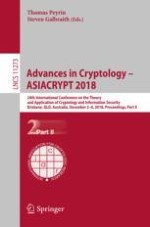2018 | OriginalPaper | Chapter
On the Concrete Security of Goldreich’s Pseudorandom Generator
Authors : Geoffroy Couteau, Aurélien Dupin, Pierrick Méaux, Mélissa Rossi, Yann Rotella
Published in: Advances in Cryptology – ASIACRYPT 2018
Publisher: Springer International Publishing
Activate our intelligent search to find suitable subject content or patents.
Select sections of text to find matching patents with Artificial Intelligence. powered by
Select sections of text to find additional relevant content using AI-assisted search. powered by
